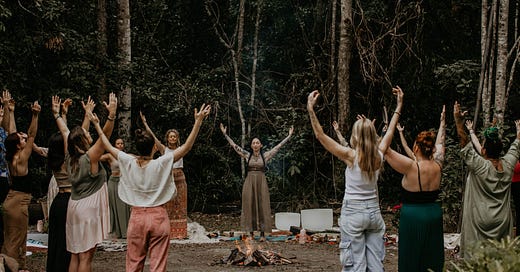Parallels in Celtic and Norse Shamanism
As a descendant of Celtic and Norse traditions, I often feel the call of my ancestors—not as a distant echo, but as a living thread weaving through my present. These ancient traditions are not separate; they share roots, wisdom, and practices that remind us of a time when the world itself was alive with spirit.
Celtic and Norse shamanic paths are mirrors of each other in many ways. Though expressed through unique cultural lenses, their shared understanding of the sacredness of nature, the power of the unseen, and the interconnectedness of all things offers timeless guidance for those seeking to reconnect with their heritage and the earth.
This post is both an honouring of these lineages and an invitation for you to explore their depths.
Animism: A Living, Breathing World
At the heart of both traditions lies animism—the belief that everything is alive with spirit. Trees, stones, rivers, and mountains were not seen as inert objects but as beings to be respected and honoured.
• In Norse tradition, spirits of nature (vættir) and land spirits (landvættir) were central to life. Rituals often included offerings to maintain harmony with these forces.
• In Celtic tradition, the sídhe (otherworldly beings) were revered as guardians of the land, and sacred waters and groves were seen as portals to the divine.
Both traditions remind us that to walk gently on the earth is to be in relationship with it—a relationship modern life often forgets.
The Otherworld and the Web of Life
Both Celtic and Norse shamanic practices are rooted in the understanding that the physical world is deeply interconnected with spiritual realms.
• In Norse cosmology, the Nine Realms are held together by Yggdrasil, the World Tree. Practitioners like the völva travelled these realms to seek wisdom and healing, often working with the threads of Wyrd—the great web of fate.
• In Celtic cosmology, the Otherworld (Tír na nÓg or Annwn) is a place of spirits, ancestors, and gods. It was accessed through dreamwork, sacred sites, and ritual, providing insight into the cycles of life and death.
These cosmologies speak of a shared truth: the unseen is not “elsewhere.” It is woven into the fabric of existence, accessible to those who dare to listen.
Trance and Song: The Path to Spirit
For both traditions, altered states of consciousness were essential to spiritual work.
• The Norse völva used chanting (galdr), rhythmic drumming, and breathwork to enter trance states. These practices opened the gates to other realms and allowed her to weave or reweave the threads of fate.
• Celtic druids and poets (fili) used song, incantation, and the sounds of sacred instruments to bridge the physical and spiritual. Harps, drums, and even the wind’s voice became tools for connection.
Trance states are not escapism; they are a return to a more profound way of knowing—one that integrates intuition, experience, and spirit.
Sacred Trees and Nature’s Wisdom
Both traditions revered the wisdom of trees as sacred beings and bridges between worlds.
• In Norse tradition, Yggdrasil, the great ash tree, stands at the centre of the cosmos, connecting all realms. Individual trees were also honoured as vessels of wisdom and strength.
• In Celtic tradition, the crann bethadh (Tree of Life) symbolises the connection between heaven, earth, and the underworld. Oaks, yews, and hazels were especially sacred, often serving as sites for ritual and communion.
These traditions invite us to view nature not as something to be controlled but as a teacher and ally, holding keys to understanding ourselves and our place in the world.
Prophecy, Divination, and the Weavers of Fate
Both Celtic and Norse traditions placed high value on prophecy and divination, seeing those who could navigate the unseen as essential to their communities.
• The Norse völva read the threads of Wyrd through trance, runes, and intuition, offering guidance and foresight.
• Celtic druids and fili used ogham (sacred script), omens, and dreams to interpret the will of the gods and the movement of fate.
In both traditions, these practices were not about controlling destiny but understanding it—working with the flow of life rather than against it.
Cycles, Fate, and Ancestral Wisdom
Both cultures viewed life as a series of cycles—birth, death, and rebirth. Time was not linear but woven, with the past, present, and future intricately connected.
• In Norse thought, the Norns spun the threads of fate at the roots of Yggdrasil, embodying the interplay of choice and destiny.
• In Celtic thought, the cycles of the seasons and the turning of the wheel of the year reflected the natural rhythms of life and death.
Both traditions teach us to embrace life’s cyclical nature, finding wisdom in its rhythms rather than resisting them.
Honouring the Lineage
To walk with the wisdom of our Celtic and Norse ancestors is to remember that the sacred is all around us. It is in the land beneath our feet, the whispers of the wind, and the stories woven into our blood.
This is not about romanticising the past but reclaiming a way of being that honours connection—to the earth, to spirit, and to ourselves.
Whether you feel the call of the völva or the druid, the message is the same: listen deeply, walk gently, and know that you, too, are a thread in this vast and intricate web of life.
Let this be an activation—a reminder of the wisdom that already resides within you and an invitation to explore it further.




